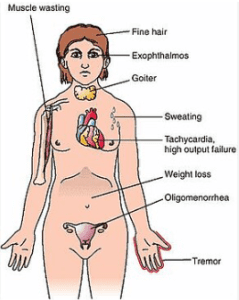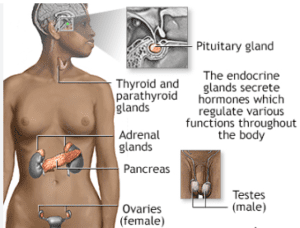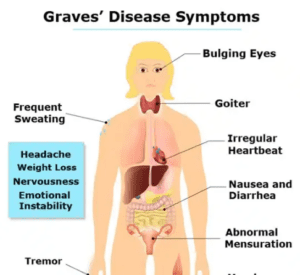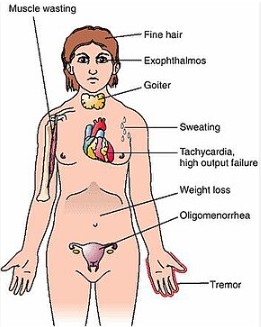Symptoms of Graves’ Disease in Females
Symptoms of Graves’ Disease in Females
Graves’ disease is an autoimmune disorder that affects the thyroid gland, leading to an overproduction of thyroid hormones. It is more common in females, and its symptoms can vary widely. Understanding these symptoms is crucial for timely diagnosis and management. In this article, we will explore the key symptoms of Graves’ disease in females and provide insights into its management.
Introduction

Graves’ disease, an autoimmune disorder, has a significant impact on the thyroid gland, causing an overactive thyroid or hyperthyroidism. It predominantly affects females and can manifest in a variety of ways.
Understanding Graves’ Disease
Graves’ disease is characterized by the production of autoantibodies that stimulate the thyroid gland to release excessive thyroid hormones. This disrupts the body’s normal metabolism and leads to a range of symptoms.
Common Symptoms in Females Graves’ Disease
1 Hyperthyroidism Signs
The hallmark symptoms of Graves’ disease in females often relate to hyperthyroidism. These include unexplained weight loss, rapid heartbeat, increased sweating, and anxiety. The body’s heightened metabolic rate can result in sudden weight loss despite a normal or increased appetite.
2 Ocular Symptoms
Graves’ ophthalmopathy, also known as thyroid eye disease, is a common manifestation. Females may experience bulging eyes, sensitivity to light, double vision, and irritation. These symptoms can significantly impact daily life and self-esteem.
3 Dermatological Signs
Certain dermatological symptoms can manifest, such as reddening and swelling of the skin, particularly on the shins and feet. This condition is known as pretibial myxedema and is more prevalent in females.
What is the main cause of Graves disease?
Graves’ disease is primarily brought on by an autoimmune reaction. In this condition, the body’s immune system mistakenly targets the thyroid gland, a small butterfly-shaped organ located in the neck. Thyroid-stimulating immunoglobulins (TSIs) or thyroid-stimulating antibodies (TSAbs) are produced as a result of this immune attack.
The thyroid-stimulating hormone (TSH), which is typically made by the pituitary gland, is imitated by these antibodies. TSH stimulates the thyroid gland to produce thyroid hormones, which regulate various bodily functions, including metabolism.
However, in Graves’ disease, the immune system’s antibodies overstimulate the thyroid gland, causing it to produce an excessive amount of thyroid hormones. As a result, the body’s metabolism is accelerated, which causes a condition known as hyperthyroidism and a variety of symptoms like nervousness, rapid heartbeat, and weight loss.
Uncertainty exists over the precise cause of the autoimmune reaction that results in Graves’ illness. The disorder is thought to be influenced by both genetic and environmental factors. Additionally, in those who are genetically susceptible, conditions including stress, infections, and certain drugs may hasten the development of Graves’ disease.
It’s important to note that while the immune system’s role in causing Graves’ disease is well-established, the exact reasons for the immune system’s misbehavior in this context are still an area of ongoing research.
Less Common Symptoms Graves’ Disease
1 Thyroid Acropachy


Thyroid acropachy involves swelling and clubbing of the fingers and toes. While less common, it can cause discomfort and may be a cause for concern.
2 Emotional Disturbances
Emotional and psychological well-being can be affected. Females with Graves’ disease may experience mood swings, irritability, and even depression. It’s essential to address both the physical and emotional aspects of the condition.
Diagnosis and Medical Evaluation
Diagnosing Graves’ disease involves a combination of physical examination, blood tests, and imaging studies. A medical professional will assess thyroid hormone levels and the presence of thyroid antibodies.
Management and Treatment Options
1 Antithyroid Medications
Antithyroid medications are commonly prescribed to inhibit the production of excess thyroid hormones. These medications help normalize hormone levels and alleviate hyperthyroidism symptoms.
2 Radioactive Iodine Therapy
Radioactive iodine therapy is another treatment option. It involves the administration of radioactive iodine, which targets and destroys thyroid cells responsible for hormone overproduction.
Lifestyle Considerations
1 Stress Management
Stress can exacerbate Graves’ disease symptoms. Females are advised to practice stress-reduction techniques such as yoga, meditation, and deep breathing exercises.
2 Diet and Nutrition
Maintaining a balanced diet rich in nutrients is crucial. Certain foods, such as those high in iodine, should be consumed in moderation.
Effect on Reproductive Health
Graves’ disease can impact reproductive health and menstrual cycles in females. It’s important for women of reproductive age to work closely with their healthcare providers to manage these effects.
Pregnancy and Graves’ Disease
Pregnancy can pose additional challenges for females with Graves’ disease. Proper medical supervision is essential to ensure the health of both the mother and the baby.
Long-term Outlook and Complications
With appropriate management, the prognosis for females with Graves’ disease is generally positive. However, uncontrolled hyperthyroidism can lead to serious complications such as heart problems and brittle bones.
Support and Coping Strategies


1 Support Groups
Joining support groups can provide females with Graves’ disease a sense of community and a platform to share experiences and advice.
2 Mental Health Care
Managing the emotional impact of Graves’ disease is crucial. Mental health care, including therapy and counseling, can offer valuable tools for coping.
Conclusion
Females experiencing symptoms of Graves’ disease should seek prompt medical attention. Early diagnosis and comprehensive management are key to minimizing the impact of the condition on their overall health and well-being.
FAQs
Q1: What are two primary signs of Graves disease?
A1: The two basic indicators of Graves’ disease are hyperthyroidism and Graves’ ophthalmopathy. Hyperthyroidism refers to an overactive thyroid gland, leading to symptoms such as fast heartbeat, unexplained weight loss, excessive perspiration, and anxiety. Graves’ ophthalmopathy, on the other hand, is a disorder where the eyes seem protruding, and sufferers may feel sensitivity to light, double vision, and eye discomfort. These two indications are typically crucial markers of Graves’ illness and should be reviewed by a medical practitioner for correct diagnosis and treatment.
Q2: Can Graves’ illness effect fertility?
A2: Yes, Graves’ illness can impair reproductive health, but with adequate therapy, fertility can typically be retained.
Q3: Are there natural therapies for controlling Graves’ disease?
A3: While certain lifestyle changes might assist, medical intervention is typically essential for optimal treatment.
Q4: Can pregnancy trigger Graves’ disease?
A4: Pregnancy itself doesn’t induce Graves’ disease, but it might intensify existing symptoms.
Q5: How frequently should thyroid function be monitored?
A5: Regular monitoring is needed, especially during therapy modifications, to ensure thyroid hormone levels are in balance.
Q6: How do you confirm Graves disease?



Clinical assessments, laboratory testing, and medical evaluations are frequently combined to confirm Graves’ illness. Here is a description of the procedure:
Medical History and Physical Exam: A healthcare professional will begin by getting a thorough understanding of your medical history, including any symptoms you may have been having. Additionally, they will conduct a thorough physical examination, looking for symptoms like a goiter and checking the eyes for any indications of Graves’ ophthalmopathy.
Blood testing: Blood testing are essential for establishing the presence of Graves’ illness. The following blood examinations are frequently carried out:
Thyroid Function Tests: Thyroid hormone (T3 and T4) and thyroid-stimulating hormone (TSH) levels are assessed during these tests. T3 and T4 levels are increased while TSH levels are typically low in Graves’ disease.
Tests for thyroid antibodies, such as thyroid-stimulating antibodies (TSAb) and thyroid-stimulating immunoglobulins (TSIs), are used to detect the existence of antibodies linked to Graves’ illness. These antibodies show that the thyroid gland has been the focus of an autoimmune reaction.
Test for the thyroid gland’s ability to absorb radioactive iodine includes ingesting or injecting a tiny quantity of the substance. The thyroid’s ability to absorb radioactive iodine can be used to gauge its activity. The uptake is frequently increased in Graves’ disease.
Thyroid Ultrasound: A thyroid ultrasound can produce finely detailed images that aid in determining the size and structure of the thyroid. This can assist in locating any anomalies, such as nodules or an enlarged thyroid.
The thyroid gland is imaged during a radioactive iodine uptake scan after the administration of a radioactive iodine tracer. It offers information on thyroid activity and function and aids in assessing the tracer’s distribution within the thyroid.
Clinical Evaluation: In addition to laboratory tests, a healthcare professional will take into account your clinical symptoms, such as nervousness, sweating, rapid heartbeat, and weight loss. These signs and symptoms, along with the outcomes of imaging and blood tests, help determine whether Graves’ disease is present.
Specialized Eye Exams: An ophthalmologist may be referred to you if there are signs of Graves’ ophthalmopathy (eye involvement) so they can perform specialized eye exams to determine the severity of the condition.
It’s crucial to remember that a combination of these factors is used to diagnose Graves’ disease. A healthcare professional will assess your unique situation and take into account all pertinent data to make an accurate diagnosis. If Graves’ disease is identified, suitable management techniques and treatment options can be explored.
Conclusion
Females experiencing symptoms of Graves’ disease should seek prompt medical attention. Early diagnosis and comprehensive management are key to minimizing the impact of the condition on their overall health and well-being. In conclusion, an accurate diagnosis and prompt treatment depend on a thorough awareness of the female-specific symptoms of Graves’ illness. Women who exhibit any of these signs should see a doctor for an accurate diagnosis and recommendations. People can successfully control their disease and enjoy happy lives if they take the appropriate approach.






Pingback: How Long Does Human Metapneumovirus Last? - AFitHelp
Pingback: Understanding the 10 Types of Mental Disorders - AFitHelp
Pingback: What Are the 10 Types of Mental Disorders - AFitHelp